
Gymnocalycium pflanzii Photo by: Valentino Vallicelli
Origin and Habitat: South-east of Bolivia(Cochabamba, Chuquisaca, Potosí, Santa Cruz and Tarija), North-West of Paraguay (Alto Paraguay and Boquerón) and North of Argentina (Provinces of Salta, Jujuy and Tucumán)
Altitude: It can be found at elevations of 500 to 2,500 metres above sea level.
Habitat: Grows often semi-buried in in deep rich sandy soil, rather in sunny rocky areas, on slopes or under spiny shrubs in the sotobosque, at the border and clearings of the dry Chaco forest. Gymnocalycium pflanziiSN|18750]]SN|18750]] has a wide range, is abundant and the threats that affect part of its range are minor. Subsistence farming, agriculture and goat grazing are minor threats to the species in parts of its wide range.
Synonyms:
See all synonyms of Gymnocalycium pflanzii
Description: Gymnocalycium pflanziiSN|18750]]SN|18750]] is a solitary or slowly clustering cactus, with peculiar spine clusters characteristically bent backward in a distinctive fashion.
Stem: Flattened-globose, 10-15 (25) cm in diameter, 10cm tall pale green, to olive green that can tinge of orangish purple in full sun. The epidermis has a velvety appearance. The apex is slightly depressed and woolly.
Ribs: 10 to 12 thick, large, divided into polygonal rounded (not chinned) tubercles, separated by arched furrows.
Roots: Fibrous
Areoles: Large long, oval 10 by 14 mm broad, with cream-yellowish wool, then blackish dismantling with time.
Spines: Strong, very stiff, bent backward, initially blackish with a brown base then becoming grey-pinkish to whitish brown with black point.
Radial spines: (5-)7-9 up to 25 mm long
Central spines:One (or two) of the same length.
Flowers: Infundibuliform near the apex, diameter and height 45-50 mm. Pericarpell dull green very short. External tepals spatulate, slightly bent outward , white with brownish green midrib. Inner tepals intern narrower, spatulate and slightly denticulate, white with carmine/pink purplish throat. Style carmine with carmine pink 10-12 lobes. Pollen yellow.
Fruits: Globose of approximately 2 cm of diameter, becoming red carmine with maturity. Pulp intense cherry-red.
Seeds: Microsemineum type, section pirisemineum, very small (0,6 X 0,4 mm), testa reddish shining and smooth.
Remarks: It is a very variable species with a wide distribution and several controversial varieties, forms and subspecies has been described. Of them only three or four has been recognized: subsp. argentinense H.Till & W.Till from Gonzales, Salta, Argentina, subsp. zegarrae (Cárdenas) G.J.Charles and subsp. dorisie coming from Tarija, Bolivia.
Subspecies, varieties, forms and cultivars of plants belonging to the Gymnocalycium pflanzii group
 Gymnocalycium marquezii Cárdenas: has shark mat type skin, dark coppery red stem and dark spines. Distribution: Tarija, Bolivia.
Gymnocalycium marquezii Cárdenas: has shark mat type skin, dark coppery red stem and dark spines. Distribution: Tarija, Bolivia. Gymnocalycium marquezii f. variegatum hort.: Variegated form.
Gymnocalycium marquezii f. variegatum hort.: Variegated form. Gymnocalycium pflanzii (Vaupel) Werderm.: Subsp. pflanzii has peculiar spine clusters bent backward. Fruits carmine with cherry-red pulp. Distribution: Bolivia, NW Paraguay and N Argentina.
Gymnocalycium pflanzii (Vaupel) Werderm.: Subsp. pflanzii has peculiar spine clusters bent backward. Fruits carmine with cherry-red pulp. Distribution: Bolivia, NW Paraguay and N Argentina. Gymnocalycium pflanzii var. albipulpa F.Ritter: has white fruit pulp. Distribution: Tarija, Santa Cruz, Cochabamba, Bolivia.
Gymnocalycium pflanzii var. albipulpa F.Ritter: has white fruit pulp. Distribution: Tarija, Santa Cruz, Cochabamba, Bolivia.- Gymnocalycium pflanzii subs. argentinense H.Till & W.Till: occurs near Gonzalez, Salta, Argentina.
- Gymnocalycium pflanzii subs. dorisiae Amerh.: occurs in Tarija, Bolivia.
 Gymnocalycium pflanzii var. riograndense (Cárdenas) Donald: has spine clusters bent backward and short-tubed flowers with bluish-red centres. Distributio: Tarija, Chuquisaca, Santa Cruz, Bolivia.
Gymnocalycium pflanzii var. riograndense (Cárdenas) Donald: has spine clusters bent backward and short-tubed flowers with bluish-red centres. Distributio: Tarija, Chuquisaca, Santa Cruz, Bolivia. Gymnocalycium pflanzii subs. zegarrae (Cárdenas) G.J.Charles: has larger stems and fruits are green or rarely orange with white pulp. Distribution: South-east of Bolivia.
Gymnocalycium pflanzii subs. zegarrae (Cárdenas) G.J.Charles: has larger stems and fruits are green or rarely orange with white pulp. Distribution: South-east of Bolivia.
Bibliography: Major references and further lectures
1) David R Hunt; Nigel P Taylor; Graham Charles; International Cactaceae Systematics Group. "The New Cactus Lexicon" dh books, 2006
2) Edward Anderson “The Cactus family” Timber Press, Incorporated, 2001
3) James Cullen, Sabina G. Knees, H. Suzanne Cubey "The European Garden Flora Flowering Plants: A Manual for the Identification of Plants Cultivated in Europe, Both Out-of-Doors and Under Glass" Cambridge University Press, 11/Aug/2011
4) Demaio, P., Lowry, M., Ortega-Baes, P., Perea, M. & Trevisson, M. 2013. Gymnocalycium pflanzii. In: IUCN 2013. "IUCN Red List of Threatened Species." Version 2013.2. <www.iucnredlist.org>. Downloaded on 17 February 2014.
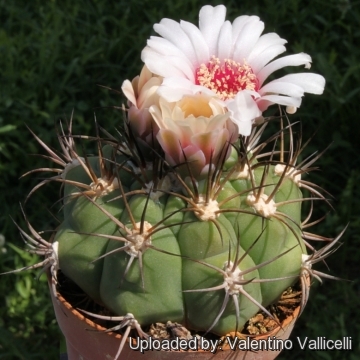 Gymnocalycium pflanzii Photo by: Valentino Vallicelli
Gymnocalycium pflanzii Photo by: Valentino Vallicelli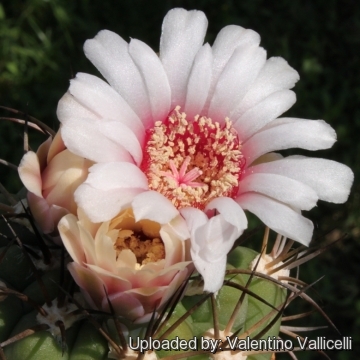 Gymnocalycium pflanzii Photo by: Valentino Vallicelli
Gymnocalycium pflanzii Photo by: Valentino Vallicelli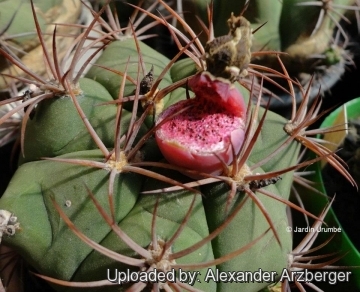 Gymnocalycium pflanzii Photo by: Alexander Arzberger
Gymnocalycium pflanzii Photo by: Alexander Arzberger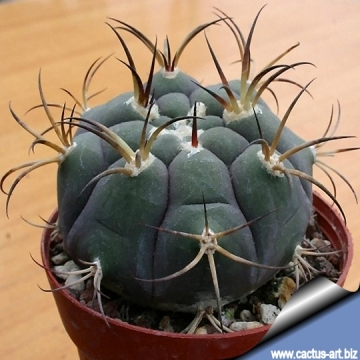 Gymnocalycium pflanzii Photo by: Cactus Art
Gymnocalycium pflanzii Photo by: Cactus Art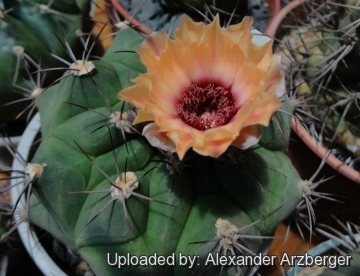 An opening flower still dark. Photo by: Alexander Arzberger
An opening flower still dark. Photo by: Alexander Arzberger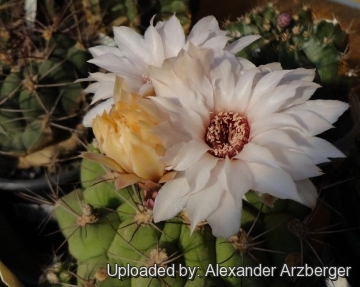 The second day the flowers change colour. Photo by: Alexander Arzberger
The second day the flowers change colour. Photo by: Alexander Arzberger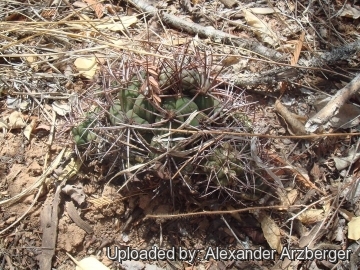 In habitat. Photo by: Alexander Arzberger
In habitat. Photo by: Alexander Arzberger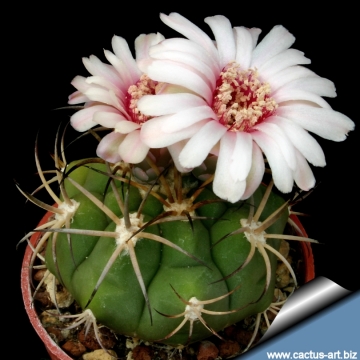 Gymnocalycium pflanzii Photo by: Cactus Art
Gymnocalycium pflanzii Photo by: Cactus ArtCultivation and Propagation: Gymnocalycium are very gratifying plants, their culture is easy and their flowering is abundant if we give them a well drained relatively rich substrate (if possible not limestone).
Growth rate: It is a relatively rapidly growing and easily flowering species.
Soils: It likes very porous standard cactus mix soil. Prefer a low pH compost, avoid substrata rich in limestone; otherwise growth will stop altogether.
Repotting: This plant needs plenty of space for its roots, repotting should be done every other year or when the it has outgrown its pot. Use pot with good drainage.
Watering: Needs moderate to copious waterings in summer, but do not overwater (Rot prone), keep dry in winter at a minimum temperature of 0°C.
Fertilization: Feed with a high potassium fertilizer in summer.
Hardiness: Reputedly resistant to frost if kept on the dry side prior to, and during, cold weather (hardy to -12 C ° C, or less for short periods), but for safe cultivation it is best to avoid freezing temperatures.
Exposition: The plant tolerates extremely bright situations but enjoys filtered sunlight or afternoon shade, inside it needs bright light, and some direct sun. Tends to bronze in strong light, which encourages flowering and heavy spine production, but is likely to suffer from sun scorch or stunted growth if over exposed to direct sunlight during the hottest part of the day in summer.
Uses: It is an excellent plant for container growing. It always looks good and stays small. It look fine in a cold greenhouse and frame or outdoor in a rockery.
Pests & diseases: It may be attractive to a variety of insects, but plants in good condition should be nearly pest-free, particularly if they are grown in a mineral potting-mix, with good exposure and ventilation. Nonetheless, there are several pests to watch for:
- Red spiders: Red spiders may be effectively rubbed up by watering the plants from above.
- Mealy bugs: Mealy bugs occasionally develop aerial into the new growth among the wool with disfiguring results, but the worst types develop underground on the roots and are invisible except by their effects.
- Scales: Scales are rarely a problem.
- Rot: This species is particularly easy and accommodating, seldom suffer of cryptogamic diseases. Rot it is only a minor problem with gymnocalyciums if the plants are watered and “aired” correctly. If they are not, fungicides won't help all that much.
Propagation: Usually by Seeds.. Seeds germinate in 7-14 days at 21-27° C in spring, remove gradually the glass cover as soon the plants will be well rooted (ca 1-2 weeks) and keep ventilated, no full sun for young plants! The grafting is useless (excluded the cultivars deprived of chlorophyll), it does not bring anything concrete.
Your Photos
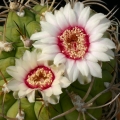
by Valentino Vallicelli
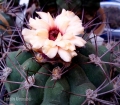
by Alexander Arzberger

by Alexander Arzberger





















